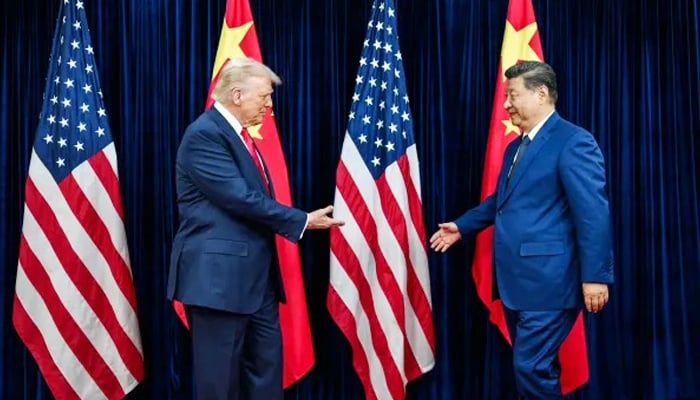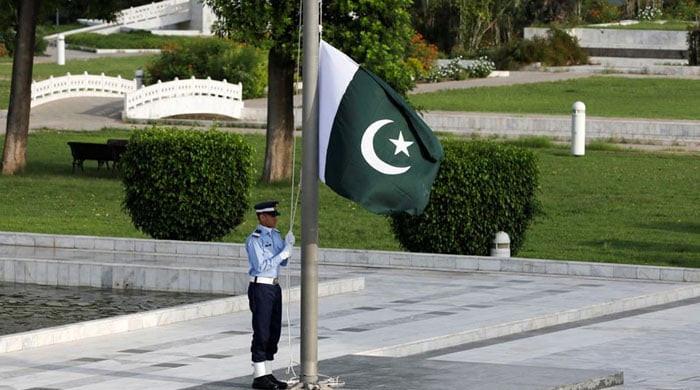How is China sustaining US pressure?
A lot can be learnt from how China is sustaining US pressure and at the same time developing its economy and improving security
November 10, 2025

A trade and economic deal between US President Donald Trump and his Chinese counterpart Xi Jinping has relatively lowered the temperature between the two nations.
Starting from today, both countries are taking a number of measures to ease restrictions and de-escalate the rising tensions. The window, however, is short as these steps are being taken only till November 10, 2026.
In other words, China has somehow delayed an imminent economic escalation with the United States for at least one more year.
President Trump is right to claim “victory" as he has secured Chinese assurances to halt the flow of precursors used to make fentanyl, eliminate to a great extent “China’s current and proposed export controls on rare earth elements”, end Chinese retaliation against US semiconductor manufacturers, and open the market to US soybeans and other agricultural exports”.
Meanwhile, China is equally suspending the retaliatory tariffs and suspending or removing all of the non-tariffs that it has announced since March 4, 2005.
Beijing is further removing measures it “took in retaliation for the US announcement of a Section 301 investigation on China’s targeting the Maritime, Logistics and Shipping Sectors for Dominance”, and removing “sanctions imposed on various shipping entities”.
Not only that, Beijing will terminate “various investigations targeting US companies in the semiconductor supply chain, including its anti-trust, anti-monopoly, and anti-dumping investigations”.
On the other hand, President Xi has ensured that the United States will lower the tariff on “Chinese imports imposed to curb fentanyl flows by removing 10% of the cumulative rate effective November 10,2025”.
From today, the United States will also suspend for one year “the implementation of the interim final rule title Expansion of End-User Controls to Cover Affiliates of Certain Listed Entities.”
At the same time, the United States is suspending “implementation of the responsive actions taken pursuant to the Section 301 investigation on China’s targeting the Maritime, Logistics, and Shipbuilding Sectors for Dominance”.
Those who keep an eye on the gradual rise of China know that this win-win situation has provided President Xi a unique opportunity to start implementing the next five-year plan.
This 2026-2030 pathway to development plan is based on the “reform and open up” formula. It is worth looking at the goals set for the next half decade.
A communique released after the plenary session of the Communist Party of China Central Committee focuses on achieving greater self-reliance, enhancing strength in science and technology, and building a modernised industrial system.
The completion of the 14th five-year plan (2021-2025) has already transformed China into a major economic power. This is achieved by maintaining steady growth despite mounting pressures.
Unlike Pakistan and many other countries, where implementation faces challenges, China has a different story to tell about its five-year planned projects. This country has achieved most of its goals since it first adopted such a plan in the 1950s.
China has a population of 1.4 billion people. It includes over 400 million Chinese citizens who are bracketed in the middle-income class.
It’s a number far greater than the total population (approximately 340.1 million) of the United States of America. Not only that, through sustained economic growth and targeted measures, China also lifted approximately more than double (800 million) people out of poverty.
In the next 10 years, it is aiming to bracket them in the middle class. Beijing has called it realising the dream of socialist modernisation.
And that is why the developmental plan focusses on boosting consumption, meeting the domestic demand, expanding effective investment, and developing a unified market on a priority basis. The ruling party is encouraging “breakthroughs in developing new quality productive forces, fostering a new pattern of development, and building a modernised economy."
It is upgrading traditional industries, setting up industries of the future, developing advanced manufacturing clusters, promoting technological transformation, and shifting toward digital and intelligent development in the manufacturing sector.
It has an eye on "quantum technology, biomanufacturing, hydrogen and nuclear fusion power, brain-computer interfaces, embodied artificial intelligence (AI) and 6G mobile communications".
CPC is encouraging the country to "steer the transformation of scientific research paradigms with AI, apply AI tools in industrial development, cultural advancement, public wellbeing indicators, social governance and strive to gain an edge in AI industrial application".
On the international front, it aims at creating “new horizons for mutually beneficial cooperation”. For that, CPC intends to further open up China, expand two-way investment and pursue high-quality Belt and Road cooperation.
"Rail freight transportation between China and Europe and between China and other parts of Asia should be improved, and construction on the New International Land-Sea Trade Corridor should pick up speed."
But CPC warns that these overseas interests should also be better protected.
Finally, comes efforts to strengthen the national security shield. After all, China is keeping a track of how historical changes are unfolding across the world, especially in the Middle East, and as a result of the Russia-Ukraine war.
Hence, without naming Washington, the communique says: “Unilateralism and protectionism are on the rise, and hegemonism and power politics pose greater threats. The international economic and trade order is facing grave challenges. Major-country rivalry is becoming more intricate and intense than ever.”
“We must better prepare ourselves for worst-case scenarios, effectively prevent and mitigate all kinds of risks, and enhance the resilience of our economy and society,” warns the communique.
It equally stresses speeding up the development of advanced combat capabilities, and the centenary goals of the People's Liberation Army (PLA) must be achieved by 2027.
"We should roll out major defence-related projects in a bid to translate advanced technologies into combat effectiveness, and development of advanced weaponry and equipment," underscores CPC.
At the top of it, Central role of President Xi, who has played a pivotal role in transforming China, is being ensured.
A lot can be learnt from how China is sustaining US pressure and at the same time developing its economy and improving security. Till now, it has failed adversary of seeing any type of “Colour Revolution” as well.
The key to everything is putting the people and the country first.
Disclaimer: The viewpoints expressed in this piece are the writer's own and don't necessarily reflect Geo.tv's editorial policy.
The author is Controller News at Geo News. He posts on X at @NasimHaider2 and can be reached at [email protected]









